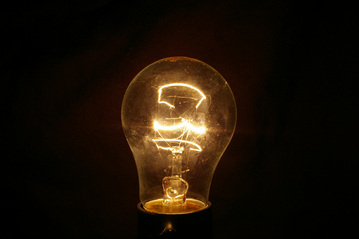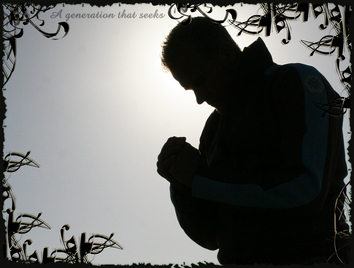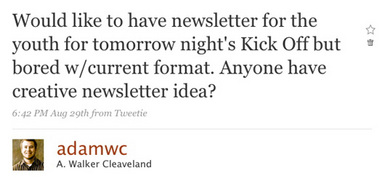You are the light of the world—like a city on a hilltop that cannot be hidden. No one lights a lamp and then puts it under a basket. Instead, a lamp is placed on a stand, where it gives light to everyone in the house. In the same way, let your good deeds shine out for all to see, so that everyone will praise your heavenly Father. - Matthew 5:14-16
I've taught on this passage several times in youth ministry. It's a great illustration that Jesus gives regarding our responsibility to shine in the darkness. This go around I wanted to do something different though, so I set out three objects: a light bulb, a picture of the moon, and one of those glow-in-the-dark stars you can put on your ceiling.
Then I went through something along these lines:
Light Bulb
This bulb, when illuminated, can light up a whole room. But can this bulb, by itself, produce light? No. What does it need to shine? (Answer - it needs to be plugged in to a power source.)
The Moon
The moon, when it's full, can be a source of light in the darkest night. But does the moon, by itself, produce light? No. What does it need to shine? (Answer - it needs to be tilted toward the sun so it can reflect its light.)
Glow-in-the-Dark Star
This star, when you turn off the lights, glows a comforting light. But how does this star get its glow? Does it, by itself, produce light? No. What does it need to shine? (Answer - it needs to be in the light so it can absorb it and then re-emit it as it glows.)
Then you ask students something like this: now what about you? Does a human being, by him/herself, produce light? No. What do we need to shine? (We need God's presence, His power in our lives.)
Then you could ask students what item they think most represents us - are we more like the bulb, needing to be plugged in to the Source of power; are we more like the moon, we need to be turned toward God so we can reflect His light; or are we more like the star, we need to be in God's presence, absorbing His light so we can re-emit it?
When I did this with students, it was awesome! Object lessons can be a powerful tool to use with your group, and every time a student sees a light bulb, one of those stars, or the moon, they may remember that they are called to be the light of the world!!!
Saw a great question online today from a YM friend. She was asking about keeping track of hours in youth ministry. I'm lucky in that I don't have to keep official time-sheets or anything like that in my job.
HOWEVER, there are two things I do that I consider healthy practices:
#1 - I always keep my pastor and my administrator informed of what I have going on. Meetings, lunches, projects, etc. Even communicating in a general sense what I'm up to helps them to know where I'm at and lets them avoid having to give an "I don't know" or other awkward answer to the question "what is the youth minister doing?"
#2 - I keep a flexible "time map". This is a basic guide to what I'm doing during the week. I break each day down in to three sections - morning (8-12), afternoon (1-5), and evening (5-9), and then assign each block the general tasks I seek to accomplish during that time. If you're interested, here's what my time map looks like:
MONDAY
Morning - Staff meeting, administrative tasks.
-----
Afternoon - Office stuff, calendar review (long and short term), event/activity planning.
-----
Evening - Family time.
TUESDAY
Morning - Midweek program prep/set-up, office stuff, miscellaneous ministry "to-dos".
-----
Afternoon - Midweek program prep/set-up, relational time with students.
-----
Evening - Family time.
WEDNESDAY
Morning - Message prep, reading, writing, web stuff (from home).
-----
Afternoon - Midweek program "finishing touches", visioneering, "marketing" (newsletters, e-mails, FB stuff, etc.) (from home).
-----
Evening - Midweek youth program.
THURSDAY
Morning - Small group prep, volunteer connections (from home).
-----
Afternoon - Weekend worship/program prep, office stuff.
-----
Evening - Flex-time (sometimes family, sometimes relational time with students).
FRIDAY
Morning - Flex-time (finishing up anything left to do for the weekend, from home).
-----
Afternoon - Home/house stuff (cleaning, laundry, etc. - yeah, I do that stuff!).
-----
Evening - Family (date with my wife!).
SATURDAY
Sabbath/family time ALL DAY.
SUNDAY
Morning - Worship/program time.
-----
Afternoon - Flex-time (family, students, or meetings).
-----
Evening - Program time.
That's it! What does your week look like?
I had the opportunity yesterday to preach the morning service at FBCCS. I really enjoyed preparing for and delivering this message, and, as usual, I learned more studying and getting ready than I'm sure most people got out of it! You can check it out by clicking right here. I'd love to know what you think! - Tim B.
I HATE publishing regular newsletters. Not because I hate communication, but because it just seems like tedious busywork to me. BUT I may change my mind after getting linked to this FREE (or if you can, make a donation!) newsletter template over at Adam Walker Cleaveland's blog! I LOVE the look of this and can't wait to try it out in my ministry. Maybe you can use it in yours! - Tim B.
Great video from Student Life!
The news of Osama bin Laden's death and the subsequent discussion on how Christians should appropriately respond to it has DOMINATED the internet this week (at least the part I frequent), and I know that many youth workers are looking for ways to engage young people in discussion about how exactly we can respond in a godly way to the past week's events.I'm using an inductive study and discussion format this week to discuss ObL's death, violence, justice, and God's heart with students. Instead of having a "sermon" or message where I give only my perspective on the issue, I think it's important to involve students in the discussion and come to some "conclusions" (using that word loosely!) together. Frankly, I'd be lying if I said I knew exactly how to feel about the whole thing. But I embrace the opportunity to discuss, discern, and discover what it means to follow Christ well in the midst of what I think we'd all agree is a profound moment in our generation.I'd love to share the study and discussion guide with you.Here's the student sheet - use this at the front end of your discussion to get students thinking biblically about violence, justice, death, sin, etc.Here's the discussion guide - use this to move your students through a discussion on the issues.Let me know how it goes!- Tim B.
|





 RSS Feed
RSS Feed
